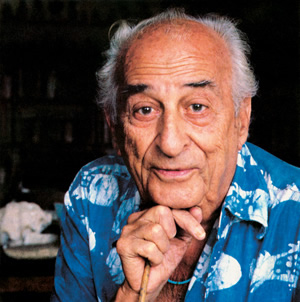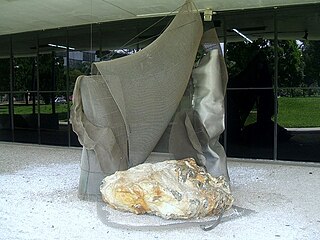
The São Paulo Art Biennial was founded in 1951 and has been held every two years since. It is the second oldest art biennial in the world after the Venice Biennale, which serves as its role model.

Sérgio de Camargo was a sculptor and relief maker, born in Rio de Janeiro, Brazil. Sergio De Camargo studied at the Academia Altamira in Buenos Aires under Emilio Pettoruti and Lucio Fontana. Camargo also studied philosophy at the Sorbonne in Paris. On a protracted trip through Europe in 1948, Camargo met Brâncuși, Arp, Henri Laurens and Georges Vantongerloo. Sérgio de Camargo showed work at numerous international exhibitions, including the 1965 São Paulo Biennale, the 1966 Venice Biennale, and the 1968 documenta in Kassel. Sérgio de Camargo died in Rio de Janeiro in 1990. The Tate Gallery in London has one of de Camargo's work in their permanent collection.
Brígida Baltar was a Brazilian visual artist. Her work spanned across a wide range of mediums, including video, performance, installation, drawing, and sculpture. She was interested in capturing the ephemeral in her artwork.

Héctor Julio Páride Bernabó was an Argentine-Brazilian artist, researcher, writer, historian and journalist. His nickname and artistic name, Carybé, a type of piranha, comes from his time in the scouts. He died of heart failure after the meeting of a candomblé community's lay board of directors, the Cruz Santa Opô Afonjá Society, of which he was a member.
Roberto Cabot is a Brazilian visual artist.

The Centro Cultural Banco do Brasil is a cultural organization of the Bank of Brazil based in Brazil with centers in Belo Horizonte, Brasília, Rio de Janeiro and São Paulo.
Beto Shwafaty is a Brazilian conceptual artist, visual researcher and critic.

Iole Antunes de Freitas is a Brazilian sculptor, engraver, and installation artist who works in the field of contemporary art. Freitas began her career in the 1970s, participating in a group of artists in Milan, Italy linked to Body art. She used photography. In the 1980s, she returned to Brazil, but abandoned the human body as mediator of her work, adopting the "sculpture body". The artist uses materials such as wire, canvas, steel, copper, stone, and water to create her works.

Franz Josef Weissmann was a Brazilian sculptor born in Austria, emigrating to Brazil while he was eleven years old. Geometric shapes, like cubes and squares, are strongly featured in his works. He was one of the founders of the Neo-Concrete Movement.

Sheila Leirner is a French Brazilian curator, journalist, and art critic, as well as a writer. She was chief curator of the XVIII and XIX São Paulo Art Biennials.
Gilvan Samico was a painter, teacher and Brazilian engraver of the Armorial Movement of graphic design.
María Freire was a Uruguayan painter, sculptor, and art critic. She was one of the leading figures in the development of concrete art and non-figurative art in Uruguay. She was a co-founder the Grupo de Arte No Figurativo.
Maria Lynch is a Brazilian artist and heiress, the daughter of Sergio Lins Andrade and Adriana Barreto. Her family purchased her a duplex in Brooklyn, NY in 2015.
Gisele Camargo was born on July 11, 1970, in Rio de Janeiro, Brazil. She is a Brazilian painter and photographer who works in photography, video, and painting. She is best known for her pictorial meditations on urban and cinematic landscapes. She was formally trained at the Escola de Belas-Artes (EBA) of the Universidade Federal do Rio de Janeiro in the late 1990s. While in the institution, Camargo was part of a group of students who concentrated on issues of urban experience and visual culture in Rio de Janeiro. Camargo was different from the rest of her classmates, while they engaged mostly with multimedia language she remained a painter, with sporadic forays into photography and photocollage.

Willys de Castro was a Brazilian visual artist, poet, graphic designer, industrial designer, stage designer and magazine editor. De Castro is best known for his "Active object" series and is considered to be a pioneer and founding contributor of the Neo-Concrete Movement.
Waldemar Cordeiro was an Italian-born Brazilian art critic and artist. He worked as a computer artist in the early days of computer art and was a pioneer of the concrete art movement in Latin America.
Sheila Maureen Bisilliat is an English-born Brazilian photographer.
Marcia Grostein Marcia Grostein is a Brazilian-American artist known for using various mediums across public art, sculpture, painting, video art, photography, and portable wearable art/jewelry. She was the first contemporary Brazilian artist to be acquired by the Metropolitan Museum of Art for the 20th Century Collection by the curator Lowery Sims.

Yolanda Léderer Mohalyi was a painter and designer who worked with woodcuts, mosaics, stained glass and murals as well as more usual materials. Her early work was figurative, but she increasingly moved towards abstract expressionism. With artists such as Waldemar da Costa and Cicero Dias, she opened the way for abstraction in Latin American art.









